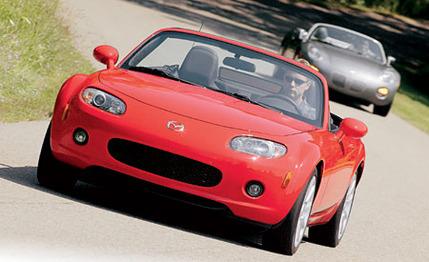
 Road Test
Road Test
First things first: The 2006 Mazda MX-5 is a complete break from its predecessor, with a new, dedicated platform and fresh bodywork. It also exchanges the old B-family engine for a 2.0-liter version of Mazda's corporate four-cylinder engine that's used far and wide in Mazda and Ford lineups. And inexplicably, the new car gets rid of a name that has meant so much to so many-Miata-and now calls itself simply the MX-5.
But since Miatas have always been about the driving experience, let's cut to the chase and tell you what you want to know. How fast is the new car? How does it handle? And does it still have that unique ability to provoke an irresistible grin from anyone who loves driving?
First, this new model is the fastest ever Miata-we know, we know, Mazda wants to forget about that name. It scoots to 60 mph in 6.5 seconds, continues through the quarter in 15 seconds flat at 91 mph, and doesn't stop accelerating until it hits 131 mph. With the exception of the 91-mph trap speed, which was equaled by the turbocharged last-generation Mazdaspeed model, each of those figures sets a record for showroom MX-5s. And this performance is hugely faster than that of the original 1990 model, which needed 16.8 seconds to cover the quarter-mile and topped out at 116 mph.
The new MX-5's numbers were achieved with the six-speed manual gearbox, which is standard on the Grand Touring edition we tested, as well as on the Sport and Limited versions of the new car. But we don't expect the performance to be much slower with the five-speed base car, as that transmission allows the MX-5 to reach 60 mph in second gear rather than requiring the extra shift to third that the six-speed does. The base model, called the Club Sport, weighs about 50 pounds less than the Grand Touring, which won't hurt its acceleration, either.
Speaking of weight, we are delighted that the new model's weight gain is so slight. At 2482 pounds, this MX-5 compresses the scales with just 102 more pounds than the second-gen Miata we tested in 1998.
Of course, the first Miata, in 1990, weighed 2210 pounds. But that model was about two inches shorter and narrower than the new car. It also had much smaller tires, 10 percent less cockpit space, brakes that were two inches smaller all around and without anti-lock control, no front or side airbags, no stability control, and 54 fewer horsepower from its engine, which was 25 percent smaller than the latest mill. In other words, the 12-percent weight increase between the first MX-5 and this newest version seems justified.
One other reason for the weight is a useful increase in structural rigidity. We rate the improvement in our perceived stiffness of this third-generation car to be as great as the improvement between the first- and second-generation Miatas. The car is rigid, with hardly any quivers or shakes.
This solid foundation allows the suspension to work effectively without any deflection or lost motion. Driven quickly over one of our favorite back roads, the new MX-5 is extremely stable even while its wheels move furiously to maintain contact with uneven pavement. The Bilstein shocks that are part of the optional $500 suspension package probably helped a lot on these roads.
On the skidpad, the new MX-5 hangs on to the tune of 0.90 g, a figure exceeded by only one of the two Mazdaspeed Miatas we've tested. What's more, if you turn off the stability control that came in the premium package on our car, the MX-5 is delightfully neutral. Although you can't easily kick out the tail with power, you can definitely balance the car with your right foot once you start cornering with enthusiasm.